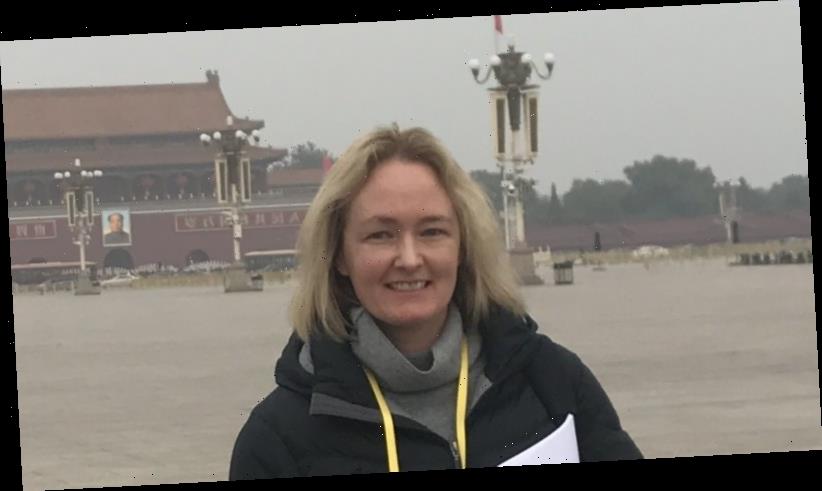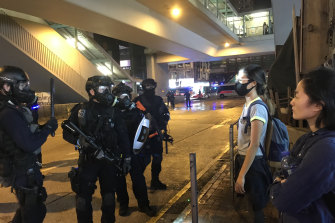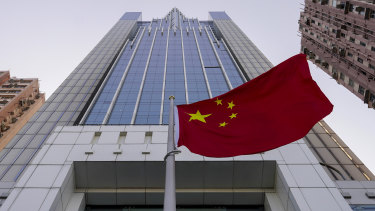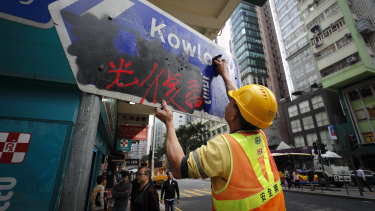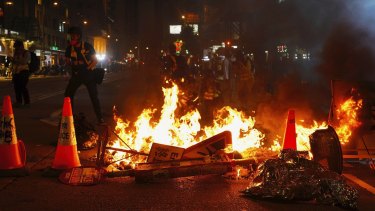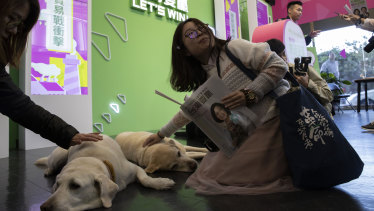Hong Kong: As the special tactical squad swept down a Mongkok side street with rifles and batons one October night, a woman barked from the footpath.
In the most densely populated place on Earth, the graffiti cried “black cops, burn with us”.
Hong Kong protests: Security forces and demonstrators face off in Mong Kok, Kowloon.Credit:Kirsty Needham
This young woman stood defiantly still, hands in pockets, as the “raptors” rushed towards her with batons raised.
A second woman stopped in her tracks and stood beside her. Together, they stared furiously, arms folded, at the men in black with pistols strapped to their thighs. They were now centimetres from the woman's face.
The police tried to block my camera with a spotlight, but under media scrutiny, backed off.
A stand-off between the water cannon and a frontline of protester umbrellas continued blocks away on Nathan Road, where Chinese banks were smouldering. But this street held only residents and shoppers – and when the police arrived, the barking erupted.
Wanting obedience or fear, the police were furious, and filled the street with tear gas.
In many other instances that night heckling from the footpath drew pepper spray to the face.
It wasn’t a bloody night, of which there have been many – broadcast live – over six months of Hong Kong protests, but it laid bare the breakdown in relations between police and a population.
International media converged on Hong Kong last year, on alert for an event that could shake the world: Would the People’s Liberation Army and martial law arrive on the streets of Asia’s sophisticated financial hub?
The Chinese flag flutters in the breeze outside China’s liaison office building in Hong Kong.Credit:AP
These would be devastating events, just as likely to spur an exodus of international capital from the city.
The ghosts of history may have held Beijing back from deploying the PLA – the isolation that followed the massacre of students in Tiananmen 30 years ago seen as too high an economic cost to repeat.
The signals now are that the communist leadership believes the fix, to what it has painted as “terrorism” on its doorstep, is reshaping minds and tightening control.
Beijing may move to dismantle the city’s lifeblood of liberal education, judicial independence and press freedom.
Recent statements from Beijing refer to the “urgent” need for a new law to uphold national security. Hong Kong dropped an attempt to introduce a national security law, covering treason and foreign interference, that was demanded by Beijing in 2003, after mass protests.
But the top Chinese official with responsibility for Hong Kong, Zhang Xiaoming, has now blamed the 2019 protests on the absence of a national security agency in the city.
In a “Letter to Hong Kong” for the New Year, Hong Kong Chief Secretary Matthew Cheung said it had been a year of “unremitting shocks”.
Detailing a toll that included 740 sets of traffic lights destroyed, 52 kilometres of roadside railing removed (for protester barricades) and 2600 people injured, Cheung went on to say that “rule of law” was a “most cherished core value”.
A worker cleans a road sign vandalised by protesters in Causeway Bay, Hong Kong.Credit:AP
He praised a “fiercely independent judiciary”, along with freedom of press, freedom of religion and free education.
But the business community is worried Beijing may seek to interfere in Hong Kong’s judiciary.
The High Court has overturned the ban on face masks introduced by Lam under emergency powers, and declared it unconstitutional. This prompted an angry response from Beijing’s legislative affairs committee, which claimed Hong Kong’s courts had no power to rule on the constitution.
An appeal against the High Court ruling will be heard this month, with Lam’s government arguing Hong Kong is “executive led” and there is no separation of powers.
Beijing has also made it known through state media it expects judges to toe the line on protest cases.
Yet as these cases come to court, many are being dismissed on weak police evidence, and high-profile democracy figures such as Joshua Wong have been released on bail.
Hong Kong officials have said one of the five protester demands – pardons for those arrested – may be possible after a court process. Beijing’s public statements show no tolerance for leniency.
In a worrying sign for a free press, police have attacked public broadcaster RTHK’s reporting on police brutality and accused the network of spreading “fake news”. Former chief executive and Beijing loyalist CY Leung called for RTHK to be audited and its funding cut.
Hong Kong’s Education Secretary Kevin Yeung told a series of mainland Chinese newspapers that a government inquiry into “liberal studies” in Hong Kong schools would soon be completed, and text books would be modified in time for the next school year.
He also said the government would sack any school principal who refused to dismiss a teacher because of protest activity.
Police, in their daily press conference, took up the theme, accusing teachers of “leading students in criminal acts” during weekend protests.
Yet any attempt to brainwash Hong Kong’s students with the patriotic education that dominates in mainland China ignores the fact that it was an earlier, failed attempt to do so that spawned Hong Kong’s protesters.
Many of Hong Kong’s top schools are run by Christian churches. The Umbrella movement of 2014 grew from Scholarism, Joshua Wong’s school student push against a plan to introduce compulsory patriotic education in 2012.
Those students have grown into 20-somethings who defiantly refuse to speak Mandarin, the language used in mainland China.
Police had arrested hundreds of school students, some as young as 11, in 2019.
A 17-year-old bludgeoned across the head on live television by police at a train station dropped out of school after developing PTSD.
The District Council election in November delivered a decisive message from Hong Kong citizens to Beijing – 90 per cent of these local government seats went to pro-democracy and pro-protester candidates.
Hong Kong toned down its official New Year’s Day celebrations amid ongoing protests.Credit:AP
That may open a small window for concessions – if only to stem the loss of pro-Beijing parliamentarians in the more significant Legislative Council elections in September. Fifty per cent of 70 seats are popularly elected.
Lam walked out of her most important annual policy speech when faced with opposition heckling from pro-democracy parties. The shouts inside the chamber will only get louder if public sentiment holds.
Lam has agreed to only one of five protester demands. A report into policing of the protests is due from her police complaints council this month. The report will have no credibility – an international panel of experts appointed by Lam has quit an oversight role and declared the council toothless.
Beijing has now sacked its top appointee in Hong Kong – Central Liaison Office chief Wang Zhimin. His failure to read public sentiment meant the Central Committee of the Communist Party of China leadership was caught off-guard by the intensity of opposition to the extradition bill that sparked the protests, and the November election result. A policy shift may follow.
A Hong Kong student pats Taiwanese President Tsai Ing-wen’s dogs during a visit to the campaign headquarters for the Democratic Progressive Party in Taipei on Thursday.Credit:AP
But don’t expect any big moves from Beijing until the end of January, and after this weekend's Taiwan election.
Taiwan’s independence-leaning President Tsai Ing-wen is leading in the polls on fears that Hong Kong’s turmoil shows Xi Jinping's formula for reunification – One Country, Two Systems – cannot work.
“Hong Kong today, Taiwan tomorrow” has become the slogan of her Democratic Progressive Party.
“Democracy and authoritarianism cannot coexist within the same country. Hong Kong’s people have shown us that ‘one country, two systems’ is absolutely not viable,” Tsai warned in a New Year’s Day speech.
Beijing doesn’t want her to win.
Only after January 11, when Taiwan’s polls have closed, may Hong Kong’s Carrie Lam finally be allowed to resign.
Source: Read Full Article
